 Seemed Like a Good Idea
Seemed Like a Good Idea Three Decades of Futile Building upon a Shaky Foundation
Published online by Cambridge University Press: 14 July 2022
There has been growing interest in the vertical integration of physicians and hospitals during the past decade, as evidenced by multiple literature reviews and research investigations.1 Historically, physicians operated small firms that provided “physicians’ services” to patients who sometimes used facilities provided by separate hospital firms at which many physicians would have “privileges.” This interest in combining the two types of organizations culminated in a December 2020 issue of Health Services Research devoted to the topic that expressed surprise (and disappointment) that integration is not “a miracle cure”.2 Just months earlier, two of the major proponents of vertical integration published a study in the August issue of Health Affairs that came to a similar, “startling” conclusion: the financial integration of physicians and hospitals (e.g., via employment) had no impact on their clinical integration (and perhaps none on quality).
To save this book to your Kindle, first ensure [email protected] is added to your Approved Personal Document E-mail List under your Personal Document Settings on the Manage Your Content and Devices page of your Amazon account. Then enter the ‘name’ part of your Kindle email address below. Find out more about saving to your Kindle.
Note you can select to save to either the @free.kindle.com or @kindle.com variations. ‘@free.kindle.com’ emails are free but can only be saved to your device when it is connected to wi-fi. ‘@kindle.com’ emails can be delivered even when you are not connected to wi-fi, but note that service fees apply.
Find out more about the Kindle Personal Document Service.
To save content items to your account, please confirm that you agree to abide by our usage policies. If this is the first time you use this feature, you will be asked to authorise Cambridge Core to connect with your account. Find out more about saving content to Dropbox.
To save content items to your account, please confirm that you agree to abide by our usage policies. If this is the first time you use this feature, you will be asked to authorise Cambridge Core to connect with your account. Find out more about saving content to Google Drive.